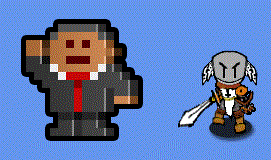Difference between revisions of "Rectangle Bounds Collision"
(→Create Player Rectangle) |
|||
| Line 65: | Line 65: | ||
==Create Player Rectangle== | ==Create Player Rectangle== | ||
<syntaxhighlight lang=csharp> | <syntaxhighlight lang=csharp> | ||
| − | // Get bounds of | + | // Get bounds of player |
Rectangle playerRectangle = new Rectangle((int)ppos.X, (int)ppos.Y, player.Width, player.Height); | Rectangle playerRectangle = new Rectangle((int)ppos.X, (int)ppos.Y, player.Width, player.Height); | ||
</syntaxhighlight> | </syntaxhighlight> | ||
Revision as of 13:04, 24 May 2024
Contents
[hide]Introduction
The textures & images used within your game have a position, and create a rectangle from that position using the height and width of the image or texture. For walls or platforms this is fine because they tend to fit well with a rectangle, however it will create a poor game if you use this method for characters. For example the image below shows a collision when only the rectangle bounds are used:
This is because the character with the sword has a transparent background which extends out beyond the other pixels, the same is true for the character in the suit.
Characters
I have declared the following Textures & 2 vectors to control the position of these:
Texture2D enemy;
Texture2D player;
Vector2 ppos, epos;
In reality your project will probably create a class for player and a class for enemy. This will then include the texture, position and so on for your character. For simplicity and for the fear of giving you a complete player class definition, or to give you a complete collision detection method, I will show you how to check for a collision between two object by creating bounding rectangles and checking for an intersection.
In the Initialize method for the game I have set the position vectors for my player and enemy:
ppos = new Vector2(0, 0);
epos = new Vector2(300, 300);
// Set a constant player move speed
playerMoveSpeed = 8.0f;
Player Movement
I have already created the basic player movement:
if (GamePad.GetState(PlayerIndex.One).Buttons.Back ==
ButtonState.Pressed || Keyboard.GetState().IsKeyDown(
Keys.Escape))
Exit();
// Save the previous state of the keyboardso we can determine single key presses
previousKeyboardState = currentKeyboardState;
// Read the current state of the keyboard and store it
currentKeyboardState = Keyboard.GetState();
if (currentKeyboardState.IsKeyDown(Keys.Left))
{
ppos.X -= playerMoveSpeed;
}
if (currentKeyboardState.IsKeyDown(Keys.Right))
{
ppos.X += playerMoveSpeed;
}
if (currentKeyboardState.IsKeyDown(Keys.Up))
{
ppos.Y -= playerMoveSpeed;
}
if (currentKeyboardState.IsKeyDown(Keys.Down))
{
ppos.Y += playerMoveSpeed;
}
This is from the Update method. It will allow your player to move around, you can't have collisions if you can't move.
Create Player Rectangle
// Get bounds of player
Rectangle playerRectangle = new Rectangle((int)ppos.X, (int)ppos.Y, player.Width, player.Height);
The (int) is an example of casting, this will convert the value ppos.X to an integer. The rectangle points are its X & Y (ie top right corner), and then the width and height are used to get the bottom left corner.
Create Enemy Rectangle
// Get bounds of enemy
Rectangle enemyRectangle = new Rectangle((int)epos.X, (int)epos.Y, enemy.Width, enemy.Height);
This is the same as above except using the enemy.
Checking if they overlap
Now we have the 2 rectangles you can check if they are touching or overlap. This can be done by checking for intersection.
// Get bounds of enemy
// Check bounds of enemy with player
if (playerRectangle.Intersects(enemyRectangle))
{
YOUR PROGRAM SHOULD DO SOMETHING HERE A COLLISION HAS HAPPENED
}
My example altered the movement values changed before the collision detection:
// Get bounds of enemy
// Check bounds of enemy with player
if (playerRectangle.Intersects(enemyRectangle))
{
if (currentKeyboardState.IsKeyDown(Keys.Left))
{
ppos.X += playerMoveSpeed;
}
if (currentKeyboardState.IsKeyDown(Keys.Right))
{
ppos.X -= playerMoveSpeed;
}
if (currentKeyboardState.IsKeyDown(Keys.Up))
{
ppos.Y += playerMoveSpeed;
}
if (currentKeyboardState.IsKeyDown(Keys.Down))
{
ppos.Y -= playerMoveSpeed;
}
}
